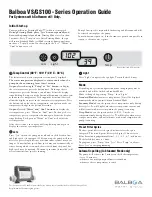
www.dimplex.de
EN-5
English
6.3
6 Installation
6.1 General Information
The following connections need to be established on the heat
pump:
Flow and return flow of the heating system
Condensate outflow
Control line to the heat pump manager
Power supply
6.2 Heating System Connection
The heating system connections on the heat pump have a 1" ex-
ternal thread.
Route the connection hoses out of the device in a downwards di-
rection. Use a spanner to firmly grip the transitions when con-
necting the heat pump. After the heat pump has been installed,
the ductwork must be sealed so that the connection is gastight.
Before connecting the heating water system to the heat pump,
the heating system must be flushed to remove any impurities,
residue from sealants, etc., and to prevent any accumulation of
deposits in the liquifier. A contaminated liquifier may cause the
heat pump to completely break down. Systems in which the heat-
ing water flow can be shut off via the radiator or thermostat
valves must be fitted with an overflow valve downstream from the
heat pump in a heating bypass (to be installed by the customer).
This ensures a minimum heating water flow rate through the heat
pump and helps to avoid faults.
Once the heating system has been installed, it must be filled, de-
aerated and pressure-tested (in the heat pump the air-relief cock
is located at or in the water pipes at the condenser).
Consideration must be given to the following when filling the sys-
tem:
Untreated filling water and make-up water must be of drink-
ing water quality (colourless, clear, free from sediments)
Filling water and make-up water must be pre-filtered (pore
size max. 5µm).
Scale formation in hot water heating systems cannot be com-
pletely avoided, but in systems with flow temperatures below
60°C the problem can be disregarded.
With medium and high-temperature heat pumps, temperatures
above 60°C can be reached.
The following standard values should therefore be adhered to
concerning the filling water and make-up water (according to VDI
2035 Sheet 1):
Minimum heating water flow rate
The minimum heating water flow rate through the heat pump
must be assured in all operating states of the heating sys-
tem. This can be accomplished, for example, by installing either
a dual differential pressureless manifold or an overflow valve.
The procedure for adjusting an overflow valve is described in the
Chapter Start-Up. When the minimum flow rate is undershot
drastically, the plate steel exchanger in the refrigerating cycle
can freeze, which can lead to total loss of the heat pump.
NOTE
The use of an overflow valve is only recommended for panel heating and
a max. heating water flow of 1.3 m³/h. System faults may result if this is
not observed.
Antifreeze
Manual drainage should be provided for heat pumps which are
exposed to frost. The antifreeze function of the heat pump man-
ager is active whenever the heat pump manager and the heat cir-
culating pump are ready for operation. If the heat pump is taken
out of service or in the event of a power failure, the system has to
be drained, and if required, blown out, at three locations (see il-
lustration). The heating circuit should be operated with a suitable
antifreeze if heat pump systems are implemented in buildings
where a power failure can not be detected (holiday home).
6.3 Electrical Connection
A standard four-core cable is used for connecting the heat pump
to the power supply.
The power supply and the control line are normally installed in
the ground (in ductwork with a suitable size and resistance) and
routed from the heat pump to the building. This ductwork must
extend into the heat pump by approx. 22 mm and be installed
with a continuous downward slope in order to comply with Sec-
tion 42 of the VDE 0100 regulations. Instead of 90° bends, two
45° bends must be used as pipe bends. The control line and the
cable for the power supply are drawn into this ductwork.
The cable (power supply) must be provided by the customer. The
conductor cross section is selected in accordance with the power
consumption of the heat pump (see Appendix Device Informa-
tion) and the applicable VDE (EN) and VNB regulations.
The power supply line on the heat pump must be fed through the
provided cable feedthrough into the switch box. The line must be
firmly screwed to its feedthrough (vapour sealed pipe union).
Total heat
output in [kW]
Total alkaline earths
in mol/m³ and/or
mmol/l
Total
hardness in dH
up to 200
2.0
11.2
200 to 600
1.5
8.4
> 600
< 0.02
< 0.11
$LUUHOLHIFRFN
&RQGHQVDWRU
Summary of Contents for LA 9 PS
Page 2: ......
Page 30: ...FR 10 Français 11 ...
Page 43: ...www dimplex de A XIII Anhang Appendix Annexes 5 ...
















































